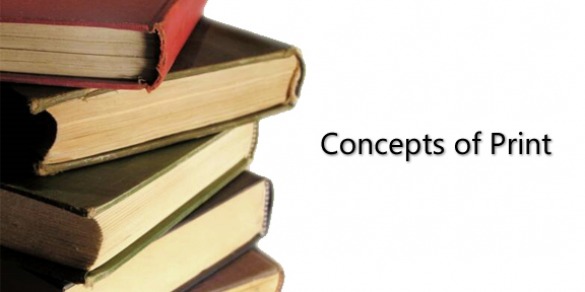the basic knowledge about how print in general, and books, in particular, “work.”
Concepts of Print Include:
The Alphabetic Principle: The understanding that words are made of letters and letters are the sounds we say when we way the words; and the understanding that by putting letters together in different ways, we make different words.
- Print that we “read.”
- Illustrations related to the print.
- Print representing language.
- Purposes of print.
- The fact that words don’t change between readings
The Alphabetic Principle: The understanding that words are made of letters and letters are the sounds we say when we way the words; and the understanding that by putting letters together in different ways, we make different words.
Definition from Bennett-Armistead, V. S., Duke, N. K., & Moses, A. M. (2005). Literacy and the youngest learner:
Best practices for educators of children from birth to five. New York: Scholastic.
Best practices for educators of children from birth to five. New York: Scholastic.
Facts About Concepts of Print:
- We read words from left to right.
- We read from word to word left to right.
- We read from top to bottom
- We use “return sweep” (when we get to the next line down, we start back at the left again.)
- Spaces separate words
- Words, sentences, and texts have a “beginning” and an “end”
- Words have a “first letter”, a “last letter”, and “middle letters”.
- The orientation of letters matters in print (a pen is a pen no matter how you hold it, but a letter could be a p, b, q, or d depending on how you hold it).
- There is a “right side up” for print.
- Different punctuations marks have different meanings
- Upper and lower case letters have purpose
- We open and hold books in a certain way.
- We turn pages of a book from left to right
- Books have a front and back, a cover, an author, and sometimes an illustrator, index, table of contents, and glossary
- Knowledge of punctuation and upper and lower case letters
- Essential to conventional reading and writing and predictive of growth of reading in the early grades.
- Can begin to be developed very early but may still be developing well into elementary school or beyond
- Don’t assume that a student knows something
Duke, Nell K. (2009). Modifications by Shedd, Megan K. Presented by Block, Meghan.Concepts of Print
and Genre [PowerPoint Slides]. Retrieved from University of Michigan State.
Concepts About Print. (2009). Retrieved April 1, 2010, from Welcome to TEAMS Educational Resources website: http://teams.lacoe.edu/documentation/classrooms/patti/k-1/teacher/assessment/print/concepts.html
and Genre [PowerPoint Slides]. Retrieved from University of Michigan State.
Concepts About Print. (2009). Retrieved April 1, 2010, from Welcome to TEAMS Educational Resources website: http://teams.lacoe.edu/documentation/classrooms/patti/k-1/teacher/assessment/print/concepts.html
Ways to Help Students Develop Concepts of Print:
- Hold the book or other text so children can see it.
- Point to words as you read them.
- Write in front of children in such a way that they can read it.
- Say words as you write them.
- Use terminology like “front,” “back,” “author,” “illustrator” and so on.
- When the time seems right, explicitly tell children about particular concepts of print (e.g., “this space here tells you it’s the end of this word”).
- Have children “help” you with concepts of print: ask questions
Activities to Help Develop Concepts of Print:
- Pretend to go to the grocery store. Have them help you create the list.
- Make a book with students using familiar photographs. Write it together and read it together, while pointing to the words as you read.
- Always keep reading to the students. Let them make predictions of the story before continuing.
- Create mini games while reading. You can count the letters or playing Eye-Spy with the words.
- Example: Eye-Spy a three letter word-and have the child find it
- Use a magnifying glass for a student to act as a “letter detective.”
Duke, Nell K. (2009). Modifications by Shedd, Megan K. Presented by Block, Meghan.Concepts of Print
and Genre [PowerPoint Slides]. Retrieved from University of Michigan State.
and Genre [PowerPoint Slides]. Retrieved from University of Michigan State.




